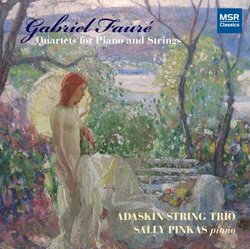| All Artists: Faure, Adaskin String Trio, Sally Pinkas Title: Faure: Piano Quartet No.1 in C minor, Op.15; Piano Quartet No.2 in G minor, Op.45 Members Wishing: 0 Total Copies: 0 Label: MSR Classics Original Release Date: 1/1/2008 Re-Release Date: 9/30/2008 Genre: Classical Styles: Chamber Music, Historical Periods, Classical (c.1770-1830) Number of Discs: 1 SwapaCD Credits: 1 UPC: 681585129326 |
Search - Faure, Adaskin String Trio, Sally Pinkas :: Faure: Piano Quartet No.1 in C minor, Op.15; Piano Quartet No.2 in G minor, Op.45
 | Faure, Adaskin String Trio, Sally Pinkas Faure: Piano Quartet No.1 in C minor, Op.15; Piano Quartet No.2 in G minor, Op.45 Genre: Classical
Gabriel Fauré, born in the south of France, studied in Paris not at the hidebound Conservatoire, but rather at the École Niedermeyer, where he received an unusually broad musical education in three respects that ... more » |
Larger Image |
CD Details
Synopsis
Product Description
Gabriel Fauré, born in the south of France, studied in Paris not at the hidebound Conservatoire, but rather at the École Niedermeyer, where he received an unusually broad musical education in three respects that set him apart from the products of the official school: a thorough understanding of older music from the Renaissance and Baroque eras, familiarity with the German tradition, including Bach and Beethoven, and a more-than-nodding acquaintance with such dangerous moderns as Schumann, Liszt, and Wagner this last element through the good offices of the young Saint-Saëns, who from 1861 on was professor of piano at the school. Fauré himself went on to become one of the most distinguished teachers of the turn of the century era (his students included Ravel and Enesco as well as Nadia Boulanger, who became a singularly influential teacher in her own right). French music in the late nineteenth century was divided into highly politicized camps the Wagnerians, the Franckists, the followers of Massenet, and others. Fauré kept largely to himself, not joining any clique. Even after making the customary pilgrimage to Bayreuth to hear the Ring, he revealed almost no influence of the experience in his own work. Thus his work has always stood somewhat apart, sometimes overlooked and misunderstood, though certain partisans--notably Nadia Boulanger--have ardently promoted it. Fauré s greatest strengths lay in the realms of song and chamber music; many of his works in both categories are treasured by performers and familiar to listeners. The First Piano Quartet is one of his most frequently performed compositions. Oddly enough, the Second Quartet, which can lay claim to being one of his finest works, is encountered relatively rarely.

 Track Listings (8) - Disc #1
Track Listings (8) - Disc #1